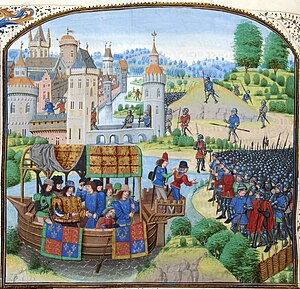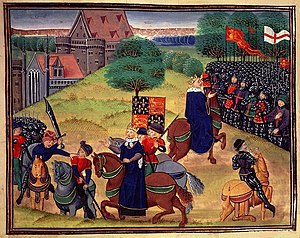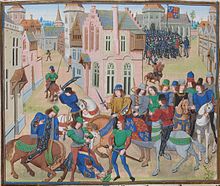Peasants' Revolt: Difference between revisions
Add detail of Richard Lyons |
|||
| Line 26: | Line 26: | ||
==Storming the Tower of London== |
==Storming the Tower of London== |
||
At the same time, a group of rebels led by [[Johanna Ferrour]]<ref name=women>[http://www.bbc.co.uk/news/magazine-18373149 BBC: Peasants' Revolt: The time when women took up arms, 14 June 2012]</ref> stormed the [[Tower of London]] and summarily executed those hiding there, including the [[Lord Chancellor]] ([[Simon Sudbury|Simon of Sudbury]], the [[Archbishop of Canterbury]], who was particularly associated with the poll tax), and the Lord Treasurer ([[Robert Hales|Robert de Hales]], the Grand Prior of the [[Knights Hospitaller|Knights Hospitallers of England]]) |
At the same time, a group of rebels led by [[Johanna Ferrour]]<ref name=women>[http://www.bbc.co.uk/news/magazine-18373149 BBC: Peasants' Revolt: The time when women took up arms, 14 June 2012]</ref> stormed the [[Tower of London]] and summarily executed those hiding there, including the [[Lord Chancellor]] ([[Simon Sudbury|Simon of Sudbury]], the [[Archbishop of Canterbury]], who was particularly associated with the poll tax), and the Lord Treasurer ([[Robert Hales|Robert de Hales]], the Grand Prior of the [[Knights Hospitaller|Knights Hospitallers of England]]). Simon Sudbury's part-mummified head is preserved in his home town of [[Sudbury, Suffolk|Sudbury]], clearly showing the axe mark<ref name=women/>. |
||
Elsewhere in London the [[Savoy Palace]] of the king's uncle [[John of Gaunt]] was one of the buildings destroyed by the rioters. The unpopular financier [[Richard Lyons (Warden of the Mint)|Richard Lyons]] was also captured and beheaded. <ref> {{cite web |url = http://books.google.co.uk/books?id=_uA9ZAKkQSkC&pg=PA454&lpg=PA454&dq=richard+lyons+Wat+Tyler&source=bl&ots=vvxD0NstB-&sig=XreXbBGMgJ4Q8NRQU8_if30KPxs&hl=en&sa=X&ei=QM4BUJyDFsTF0QWDxv2UBw&sqi=2&ved=0CEsQ6AEwAw#v=onepage&q=richard%20lyons%20Wat%20Tyler&f=false| title = A Companion to Chaucer and His Contemporaries: Texts and Contexts By Laurel Amtower, Jacqueline Vanhoutte| accessdate = 2012-07-14{}} </ref> |
|||
==Smithfield== |
==Smithfield== |
||
Revision as of 21:29, 14 July 2012


The Peasants' Revolt, Wat Tyler's Rebellion, or the Great Rising of 1381 was one of a number of popular revolts in late medieval Europe and is a major event in the history of England. Tyler's Rebellion was not only the most extreme and widespread insurrection in English history but also the best-documented popular rebellion to have occurred during medieval times. The names of some of its leaders, John Ball, Wat Tyler and Jack Straw, are still familiar in popular culture, although little is known of them.
The revolt later came to be seen as a mark of the beginning of the end of serfdom in medieval England, although the revolt itself was a failure. It increased awareness in the upper classes of the need for the reform of feudalism in England and the appalling misery felt by the lower classes as a result of their enforced near-slavery.
Events leading to the revolt
Poll tax
The revolt was precipitated by King Richard II's heavy-handed attempts to enforce the third medieval poll tax, first levied in 1377 supposedly to finance military campaigns overseas.[1] The third poll tax was not levied at a flat rate (as in 1377) nor according to schedule[2] (as in 1379); instead, it allowed some of the poor to pay a reduced rate, while others who were equally poor had to pay the full tax, prompting calls of injustice. The tax was set at three groats (equivalent to 12 pence or one shilling), compared with the 1377 rate of one groat (four pence). The youth of King Richard II (aged only 14) was another reason for the uprising: a group of unpopular men dominated his government. These included John of Gaunt (the Duke of Lancaster), Simon Sudbury (Lord Chancellor and Archbishop of Canterbury, who was the figurehead to what many then saw as a corrupt church) and Sir Robert Hales (the Lord Treasurer, responsible for the poll tax). Many saw them as corrupt officials, trying to exploit the weakness of the king.[citation needed]
The poll tax fell particularly hard on married women, who were taxed separately from their husbands regardless of their income or employment status. Women played a large part in the revolt, both as leaders and part of the general mob.[3]
Labour shortage
The Black Death that ravaged England in 1348 to 1350 had greatly reduced the labour force, and, consequently, the surviving labourers could demand higher wages and fewer hours of work. Some asked for their freedom. They often got what they asked for: the lords of the manors were desperate for people to farm their land and tend their animals. Then, in 1351, King Edward III summoned Parliament to pass the Statute of Labourers. The statute attempted to curb the demands for better terms of employment by pegging wages to pre-plague levels and restricting the mobility of labour; however, the probable effect was that labourers employed by lords were effectively exempted, while labourers working for other employers, both artisans and more substantial peasants, were liable to be fined or held in the stocks. The enforcement of the new law angered the peasants greatly and formed another reason for the revolt.
Triggering
Incidents in the Essex villages of Fobbing[4] and Brentwood triggered the uprising. On 30 May 1381, John[5] or Thomas[6] Bampton[7] attempted to collect the poll tax from villagers at Fobbing. The villagers, led by Thomas Baker, a local landowner, told Bampton that they would give him nothing, and he was forced to leave the village empty-handed. Robert Belknap (Chief Justice of the Court of Common Pleas) was sent to investigate the incident and to punish the offenders. On 2 June, he was attacked at Brentwood. By this time, the violent discontent had spread, and the counties of Essex and Kent were in full revolt. Soon people moved on London in an armed uprising.[8]
First protests
In June 1381, Kentish rebels formed behind Wat Tyler and marched on London to join the Essex contingent. When the Kentish rebels arrived at Blackheath on 12 June, the renegade Lollard priest, John Ball, preached a sermon including the famous question that has echoed down the centuries: "When Adam delved and Eve span, who was then the gentleman?"[9] The following day, the rebels, encouraged by the sermon, crossed London Bridge into the heart of the city. Meanwhile the "Men of Essex" had gathered with Jack Straw at Great Baddow and had marched on London, arriving at Stepney. Instead of a full-scale riot, there were only systematic attacks on certain properties, many of them associated with John of Gaunt and/or the Hospitaller Order. On 14 June, the rebels are reputed to have been met by the young king himself, and, led by Richard of Wallingford, to have presented him with a series of demands, including the dismissal of some of his more unpopular ministers and the effective abolition of serfdom. One of the more intriguing demands of the peasants was "that there should be no law within the realm save the law of Winchester". This may refer to the statutes of the Charter of Winchester (1251), though it is sometimes considered to be a reference to the more equitable days of King Alfred the Great, when Winchester was the capital of England.
Storming the Tower of London
At the same time, a group of rebels led by Johanna Ferrour[3] stormed the Tower of London and summarily executed those hiding there, including the Lord Chancellor (Simon of Sudbury, the Archbishop of Canterbury, who was particularly associated with the poll tax), and the Lord Treasurer (Robert de Hales, the Grand Prior of the Knights Hospitallers of England). Simon Sudbury's part-mummified head is preserved in his home town of Sudbury, clearly showing the axe mark[3].
Elsewhere in London the Savoy Palace of the king's uncle John of Gaunt was one of the buildings destroyed by the rioters. The unpopular financier Richard Lyons was also captured and beheaded. [10]
Smithfield

At Smithfield on the following day, further negotiations with the king were arranged, but, on this occasion, the meeting did not go according to plan. Wat Tyler rode ahead to talk to the king and his party. Tyler, it is alleged by the king's chroniclers, behaved most belligerently and dismounted his horse and called for a drink most rudely. In the ensuing dispute, Tyler (supposedly) drew his dagger, and William Walworth, the Lord Mayor of London, drew his sword and attacked Tyler, mortally wounding him in the neck; Sir John Cavendish, one of the King's knights, drew his sword and ran it through Tyler's stomach, killing him almost instantly. Seeing him surrounded by the King's entourage, the rebel army was in uproar, but King Richard, seizing the opportunity, rode forth and shouted, "You shall have no captain but me,"[11] a statement left deliberately ambiguous to defuse the situation. He promised the rebels that all was well, that Tyler had been knighted, and that their demands would be met—they were to march to St John's Fields, where Wat Tyler would meet them. This they duly did, but the king broke his promise. The nobles quickly re-established their control with the help of a hastily organised militia of 7000, and most of the other leaders were pursued, captured and executed, including John Ball. Following the collapse of the revolt, the king's concessions were quickly revoked. Those involved hastened to dissociate themselves in the months that followed.
The Peasants' Revolt outside London
Although the most significant events took place in the capital, there were violent encounters throughout England, particularly in East Anglia.
Norfolk
The revolt broke out in 14 June and quickly spread across the county. It was suppressed by the Bishop of Norwich, Henry le Despenser at the Battle of North Walsham on 25 or 26 June, when the local leader of the revolt, Geoffrey Litster, was captured and executed.[12]
Conclusion
Despite its modern name, participation in the Peasants' Revolt was not confined to serfs or even to the lower classes. The peasants received help from members of the noble classes—one example being William Tonge, a substantial alderman, who opened the London city gate through which the masses streamed on the night of 12 June.[13] However this is debatable; the actions of individuals like Tonge could be ascribed to fear and panic rather than rational persuasion by the rebels. [14]
Although the revolt did not succeed in its stated aims, it did succeed in showing the nobles that the peasants were dissatisfied and that they were capable of wreaking havoc. In the longer term, the revolt helped to form a radical tradition in British politics (a development explained by Christopher Hampton, see further reading). After the revolt, the term poll tax was no longer used, although English governments continued to collect broadly similar taxes until the 17th century. The Community Charge, introduced 600 years after the Peasants' Revolt, was popularly known as the poll tax (particularly by its opponents).
Literary mention

Geoffrey Chaucer mentions Jack Straw, one of the leaders of the revolt, in his satiric The Nun's Priest's Tale in The Canterbury Tales.
John Gower, a friend of Chaucer, saw the peasants as unjustified in their cause. In his Vox Clamantis, he sees the peasant action as the work of the Anti-Christ and a sign of evil prevailing over virtue, writing, "...according to their foolish ideas there would be no lords, but only kings and peasants."
Froissart's Chronicles devotes 20 pages to the revolt.
William Morris described the revolt in his novel A Dream of John Ball (1888).
The revolt is featured prominently in the climax of Anya Seton's historical novel, Katherine (1954). The main character, Katherine Swynford, survives the destruction of Savoy Palace.
"Wat Tyler," a song written by Ralph McTell and Simon Nicol and performed by Fairport Convention, is about the revolt.
Footnotes
- ^ The continuation of the Hundred Years' War initiated by King Edward III of England
- ^ The Tax Returns of the Wapentakes of Staincliffe and Ewercross are transcribed in full in Speight, Harry (1892). "The Craven and north-west Yorkshire highlands". pp. 29–60Template:Inconsistent citations
{{cite web}}: CS1 maint: postscript (link), see p 27-6; or by downloading the PDF facsimile, see pp. 38–69. - ^ a b c BBC: Peasants' Revolt: The time when women took up arms, 14 June 2012
- ^ "Peasants Revolt". UK: History learning site. 30 March 2007. Retrieved 9 July 2010.
- ^ "Citizen or subject". Exhibitions & Learning online , Citizenship. The National Archives. Retrieved 9 July 2010.
- ^ "The Peasants' Revolt 1381". Marxists. AU: ANU. Retrieved 9 July 2010.
- ^ Galbraith, Vivian Hunter (1970). The Anonimalle Chronicle (in French). ISBN 978-0-7190-0398-1.
une Thomas de Bamptoun
. Some authors (eg Vivian Hunter Galbraith in AR Myers (ed), English Historical Documents 1327–1485) have taken this as an error for John de Bampton who had been High Sheriff of both Essex and Hertfordshire a few years earlier. - ^ Maurice Hugh Keen, England in the Later Middle Ages: A Political History (Routledge, 1975)
- ^ See John Ball (priest): Notes: 3
- ^ "A Companion to Chaucer and His Contemporaries: Texts and Contexts By Laurel Amtower, Jacqueline Vanhoutte". Retrieved 2012-07-14{.
{{cite web}}: Check date values in:|accessdate=(help) - ^ Simon Schama's A History of Britain, Episode 5, 'King Death'.
- ^ Dunn (2002) pp160-5
- ^ Dobson 220
- ^ Caroline Barron, Revolt in London: 11 to 15 June 1381 (London: Museum of London, 1981) p. 3.
Further reading
- R. B. Dobson, editor (2002), The Peasants' Revolt of 1381 (History in Depth), ISBN 0-333-25505-4; a collection of source materials
- Alastair Dunn (2002), The Great Rising of 1381: The Peasant's Revolt and England's Failed Revolution, ISBN 0-7524-2323-1
- Charles Oman (1906), The Great Revolt of 1381; a classic account
- Andrew Godsell (2008), "The Peasants' Revolt and the Radical Tradition" in Legends of British History
- P. J. P. Goldberg (2004), Medieval England 1250–1550: A Social History, ISBN 0-340-57745-2; Chapter 13 is devoted to the Peasants' Revolt.
- Christopher Hampton (1984), A Radical Reader: The Struggle for Change in England, 1381–1914
- John J. Robinson (1990), Born in Blood: The Lost Secrets of Freemasonry, ISBN 0-87131-602-1; Chapters 1–5 concern the Peasants' Revolt. It makes a (somewhat speculative) case for a Knights Templar connection, tracing some revolt features (e.g., the names of leaders, especially Wat Tyler, the special targets of the destruction in London, etc.) to traditions surviving the suppression of that order and its destruction on the Continent a few generations earlier.
- A contemporary chronicle, the final meeting of King Richard II and the leader of the Peasants' Revolt, Wat Tyler.
- "The Peasants' Revolt", Voices of the powerless – readings from original sources, BBC Radio programme, Thursday 25 July 2002, 9.02 am – 9.30 am.
- Britannia: The History of the Peasants' Revolt by Jeff Hobbs with useful bibliography
- "Wat Tyler's Rebellion" from The Chronicles of Froissart
- "King Richard punishes the rebels in Kent" from The Chronicles of Froissart, edited by Steve Muhlberger, Nipissing University
- A Dream of John Ball; and, a King's Lesson by William Morris (Project Gutenberg etext)
- "Conflagration: The Peasants' Revolt" by Melissa Snell
- Fire, Bed & Bone by Henrietta Branford is a children's book looking at the Peasants' Revolt from the viewpoint of one of the participants' dogs.
